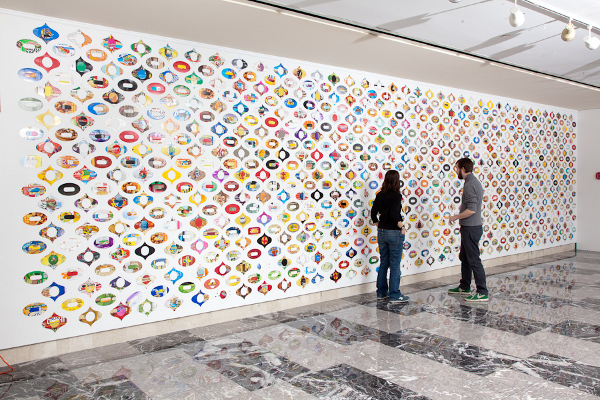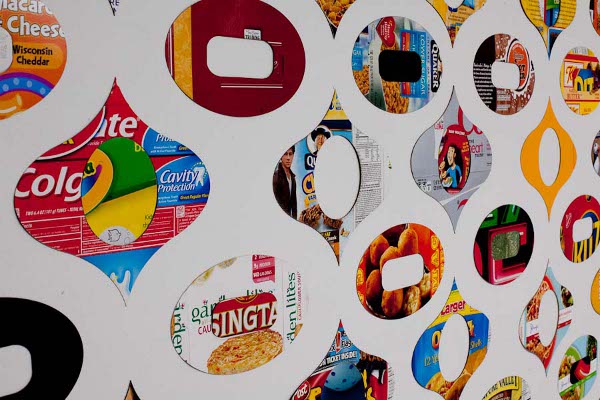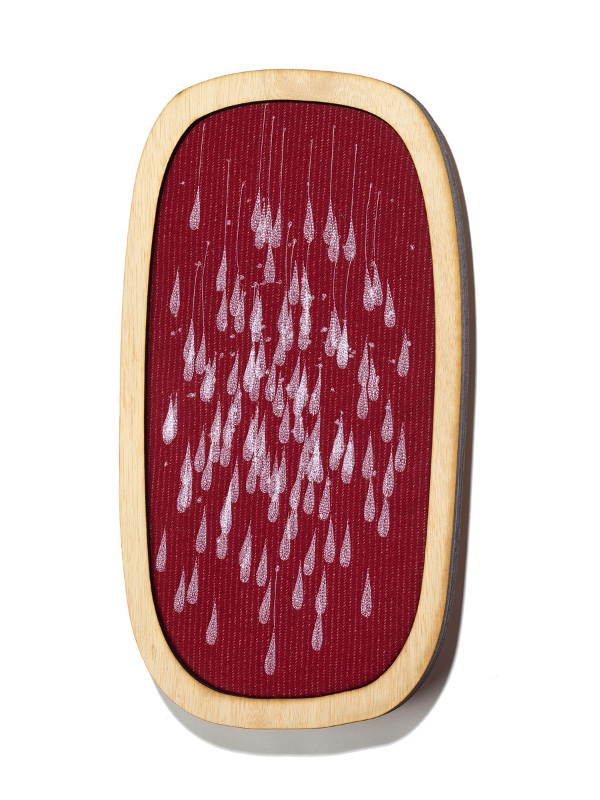
Shelley Spector’s abstract and environmental intrigue with “Dreck Groove”
Shelley Spector’s show “Dreck Groove” in the Esther Klein Gallery at University City Science Center is as much a statement about the environment and consumption as it is a study in abstraction and fiber art. The name is a take on the Yiddish word “dreck” which generally means rubbish, while “groove” hints at what someone is into, in this case consuming or recycling.
Immediately apparent as the backdrop of the space is the massive installation of ellipse and onion shapes in the rear of the gallery. Spector designed this 40-foot-long work in the style of repeating wallpaper motifs and, at a distance, the pattern prevails. As one approaches the wall however, the brand names and logos become obvious. Each of the shapes is a cutout from reclaimed cardboard. There are cereal boxes, cases of beer and boxes which formerly held toothpaste tubes. Laid out along the wall in this way, the boxes make for a visually intriguing display aside from their gimmicky starbursts and brand recognition. They also remind us that everything we consume must wind up somewhere.
The vast majority of pieces in the show are smaller individual works. In the same vein as the post-consumer wallpaper, Spector constructs the rest of the show from repurposed materials, such as fabric and thread, and even builds frames out of salvaged wood scraps. These works were created while Spector was a Breadboard Artist-in-Residence at NextFab Studio, a high-tech workshop and prototyping center located at the University City Science Center.
Some of the art is entirely abstract, while some pieces appear as plantlike forms or otherwise recognizable images. There is, predictably, an environmental thread which ties together much of the work. Embroidered raindrops fall against a murky, burgundy field, reminding the viewer of warm summer rain, or more distressingly, the effects of climate change or air pollution. After all, while some sunsets wane in hues of pink, a dark red sky would certainly be alarming.
Other works stray a bit further from the ecological themes. A pair of frames display stitched male and female names, respectively. The horizontal bars of color behind names like Franklin, Harvey and Philippe make reading the words a bit challenging, and even after making out the words, their exact intention remains somewhat mysterious.
Ultimately, Spector puts forth an exhibit, which is both visually strong and environmentally sound. The abstractions in and of themselves would be entertaining as standalones, but within their repurposed, environmental context they also bring to light issues concerning the one thing we all share: our planet.
The Esther Klein Gallery is located at 3600 Market St.; 215.966.6188.
Recent Content
-
Artsarticle ·
-
Artsarticle ·
-
Artsarticle ·




